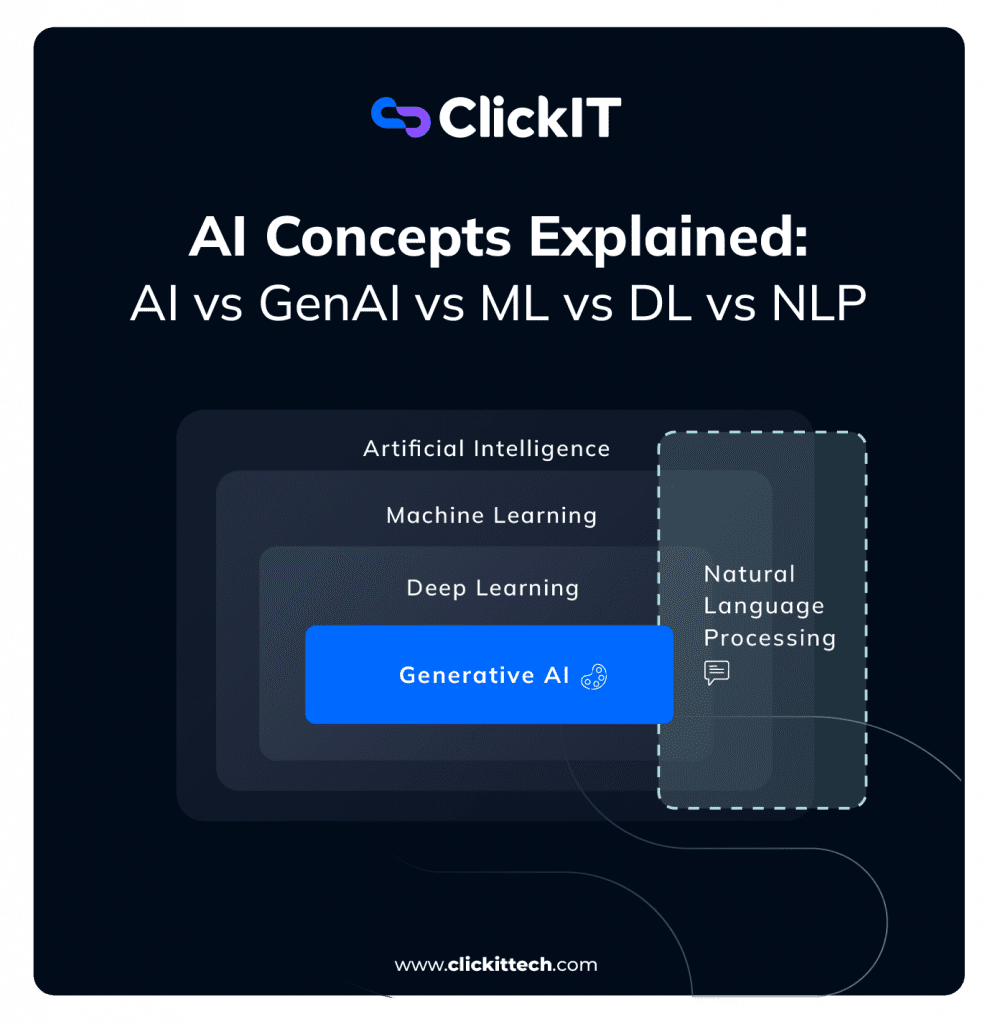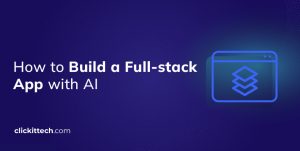Let’s simplify AI concepts like AI vs GenAI vs ML vs DL vs NLP? Artificial intelligence is the big idea that makes machines act smart. ML is how machines learn from data. DL is a potent type of ML with neural networks. NLPr enables machines to understand human language, and Generative AI generates new content such as text, images, or code.
Although these technologies are frequently combined, each has a unique function and set of capabilities. As time passed, I saw that the true game-changer is realising how they relate and differ.
Whether you’re exploring this space out of curiosity or looking to build something with AI, having the core AI concepts explained clearly can make a world of difference.
| Term | In Short |
| AI | Machines are designed to think, learn, and solve problems like humans. |
| ML | A way for machines to learn from data and improve their performance without being programmed explicitly for every task. |
| DL | Uses layered neural networks to help machines automatically learn complex patterns from large amounts of data. |
| NLP | Helps machines understand and respond to human language, whether spoken or written. |
| GenAI | Learning patterns from existing data creates new content like text, images, or music. |
- What is Artificial Intelligence?
- What is Machine Learning (ML)?
- What is Deep Learning (DL)?
- What is Natural Language Processing (NLP)?
- What is Generative AI (GenAI)?
- How They All Relate: AI vs GenAI vs ML vs DL vs NLP
- Summary of AI Concepts Explained: AI vs GenAI vs ML vs DL vs NLP
- FAQs
What is Artificial Intelligence?
AI is it’s creating machines that can think, learn, and make choices like humans, or at least try.
The science of making machines learn to perform tasks that would otherwise require human intelligence is the core of Artificial Intelligence. These tasks may be as trivial as identifying spam mail or as sophisticated as detecting diseases or navigating a vehicle.
AWS Example: Amazon Alexa is a good example of AI at work. It uses several services in AWS that allow it to listen to your voice, interpret intent, and respond like another person, whether requesting the weather or controlling smart devices.
General Example: A self-driving car uses AI to decide when to stop or accelerate based on traffic signals and surroundings.
AI doesn’t have to be costly or confusing. Let our expert AI team simplify and scale it for you.
What is Machine Learning (ML)?
Machine Learning is the fundamental mechanism behind the majority of what we currently refer to as Artificial Intelligence.
Simply put, ML is the process of teaching machines to learn from data similarly to how humans learn from experience. We provide the machine with several examples and let it identify the patterns on its own, rather than writing comprehensive instructions for each task.
That blew my mind at first. I always assumed that coding entailed issuing detailed instructions. However, machine learning is more like “Here’s a tonne of data, now figure it out yourself.“
AWS Example: Amazon Personalize is an AWS service that automatically creates real-time product recommendations with machine learning. It enables capabilities such as “Customers who bought this also bought….” by analyzing users’ behavior and preferences on Amazon’s retail platform.
General Example: Netflix uses machine learning to recommend shows based on your viewing history and preferences.
Want to make your app smarter? We integrate ML into your app to deliver personalized, data-driven experiences fast.

What is Deep Learning (DL)?
Using neural networks—systems modelled after the way our brains process information—to teach machines is merely a subset of machine learning.
The name “deep” refers to these neural networks having many layers. Deep learning selects the important information from the data on its own, whereas traditional ML models frequently require human intervention.
AWS Example: Amazon Rekognition uses deep learning models to provide advanced capabilities for image and video analysis. For instance, a deep learning model can automatically detect faces, objects, or even hazardous elements in uploaded photos and videos from surveillance devices.
General Example: Facial recognition on smartphones uses deep learning to identify and unlock the device accurately.
What is Natural Language Processing (NLP)?
NLP is the underlying link between machines and human language. This field of AI aims to enable computers to comprehend, understand, and even generate human language, whether spoken or written. It commonly overlaps with deep learning and machine learning.
You employ language rich in emotion, vagueness, grammatical abnormalities, and slang when you talk or write. For NLP to be able to figure out what you meant, it first decodes that into a machine-readable format, like numbers or patterns.
AWS Example: Amazon Comprehend is an NLP service that can review text and extract insights. It can also automatically review customer reviews and identify whether they contain positive or negative sentiments, extract key phrases from text, or identify people’s names, dates, and locations from longer documents.
General Example: Siri or Alexa understanding and responding to voice commands in natural language.
What is Generative AI (GenAI)?
Located deep within the AI family tree, generative AI is a subset of deep learning that overlaps with NLP. GenAI’s unique feature is that rather than merely evaluating or categorising data, it produces new content that appears to have been created by a human, including text, images, music, voice, and even videos. Imagine GenAI as a highly intelligent creative assistant that has been trained on enormous amounts of data. It creates new content by “learning” patterns in the data that already exists.
AWS Example: With Amazon Bedrock, developers can build GenAI applications using foundation models developed by leading AI startups such as Anthropic (Claude), Stability AI and more, all with a common API. This can generate text summaries, chatbots or even generate images with minimal effort.
General Example: ChatGPT generates human-like responses to text prompts, enabling conversational AI.
Till this point, you’ve seen how each of these concepts, AI, ML, DL, NLP and GenAIbuild upon one another. But if you’re like me, visualizing it makes the connections much clearer.

How They All Relate: AI vs GenAI vs ML vs DL vs NLP
To better understand how Artificial Intelligence, Machine Learning, Deep Learning, Generative AI, and Natural Language Processing (💬) all fit together, let’s break them down with a visual diagram.
This representation helps simplify their relationships and aids in having the core AI concepts explained clearly:

At some point, I had all these phrases floating around my brain: AI, ML, DL, GenAI, NLP, and I just could not understand how they connected to each other. So I did what I generally do when I am stuck: I sketched a diagram.
Picture large rectangles nested within rectangles, with a few overlapping along the edges.
- Artificial Intelligence: At the most superficial level, Artificial Intelligence is the parent discipline encompassing everything related to machines emulating human intelligence.
- Machine Learning: Within AI resides Machine Learning, where machines begin to learn from experience instead of being instructed precisely what to perform. This was my initial “aha!” moment.
- Deep Learning: A rich subset of ML that relies on neural networks to learn automatically from raw input, such as images or voice.
- NLP: which enables machines to comprehend and respond in human language, overlaps both ML and DL. That made perfect sense when I understood that earlier NLP models were constructed using classical ML, and the newer ones (such as ChatGPT) depend mainly on DL.
- Generative AI: Nestled within DL and overlapping with NLP. It creates new content such as text and images, typically in natural language. This is where ChatGPT and Claude hang out.
That graphic helped me tie everything together, and I hope it makes things click for you as well.
Comparison of AI vs GenAI vs ML vs DL vs NLP
| Parameter | AI | ML | DL | NLP | GenAI |
| Definition | Machines mimicking human intelligence | Machines learning from data | Neural-network-based learning from large datasets | Machines understanding and processing human language | Creating new content (text, images, etc.) using learned data patterns |
| Core Idea | Imitate human intelligence | Learn patterns from data | Use multiple neural network layers to process complex data | Translate human language into machine-understandable format | Generate original outputs from training data |
| Dependency | Parent domain of all | Subset of AI | Subset of ML | Overlaps with ML & DL | Subset of DL; overlaps with NLP |
| Human-like Ability | Reasoning, problem-solving, decision-making | Learning from examples | Perception (seeing, hearing, etc.) | Language comprehension | Creativity, content generation |
| Example | Amazon Alexa, Siri, self-driving cars | Netflix recommendations, fraud detection | Face recognition, voice assistants | Chatbots, sentiment analysis, auto-summarization | ChatGPT, DALL·E, Claude, Stable Diffusion |
The similarities and differences between AI, ML, DL, GenAI, and NLP should now be clear to you, especially with these AI concepts explained in a simplified manner. Knowing these basics opens the door to more exploration, whether you want to become a researcher, developer, or just an informed user. The AI space is rapidly evolving, and this is just the beginning.
FAQs about AI vs GenAI vs ML vs DL vs NLP
Everything mentioned above! It is a type of GenAI, built with Deep Learning (a subset of ML), and ultimately an AI invention.
Not always. While some resources let you learn about AI without knowing how to code, knowing how to program will be helpful if you want to go deeper.
No. Machine Learning is not equal to Artificial Intelligence, rather it is a part of Artificial Intelligence. AI is the general term for machines to perform tasks intelligently, and ML is all about machines learning from data without being programmed specifically.
Begin with Artificial Intelligence for the overall understanding, then transition into Machine Learning. Once you are familiar, branch out into Deep Learning, NLP, and lastly Generative AI, as they are interconnected.
Luis Chavez | Co-author






